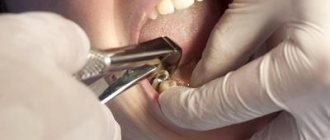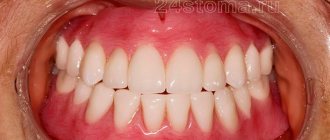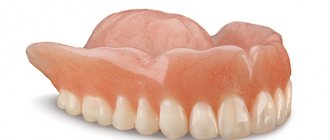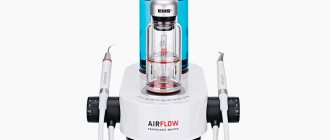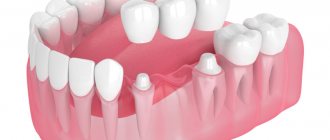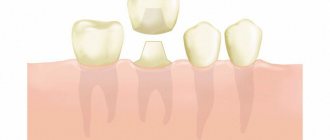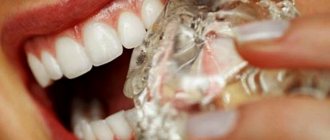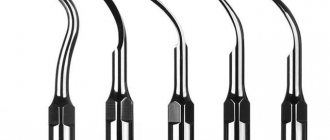If there is a possibility of preserving the masticatory organ, the dentist will definitely offer it to the patient. In desperate situations, the dentist will prepare the patient for surgery. Extraction during an acute inflammatory process is painful, even on the upper jaw. Therefore, if the surgeon suggests pulling out a tooth, there is no need to wait for the inflammation to worsen. It is better to come to the appointment in the morning, so that by the evening the pain will decrease, the stress will subside, and the night will pass peacefully. It is better to go to the clinic well-fed:
- Hungry patients are nervous and irritable;
- After the operation, the patient will not be able to eat for 3-4 hours;
- Discomfort due to surgery interferes with normal satiety;
It is forbidden to drink alcoholic beverages before extraction so as not to cause bleeding. m, since alcohol changes the structure of the blood. If a complex operation is planned, especially on the lower jaw, the doctor may prescribe anti-inflammatory drugs or antibiotics. The medications are taken on the day before the extraction.
What is the tooth extraction procedure?
Removal or extraction is a dental surgical operation during which a tooth is removed from the alveolus of the jaw in whole or in part. In the first case, the crown and root part are removed, in the second, resection or hemisection is performed while preserving the dental unit.
- Complete removal - removal of the crown and roots after separation of the soft tissues and rupture of the ligaments. It is indicated in cases of loosening, significant tooth decay, jaw fractures, or the need for orthodontic (for example, braces) or orthopedic treatment.
- Resection is the excision of the apex of the affected root; it is performed when a granuloma or cyst is detected on it. Access is carried out microsurgically through the soft tissue and jaw bone in the projection of the inflamed area or neoplasm.
- Hemisection is the amputation of one of the roots of multi-rooted (chewing) teeth along with the adjacent part of the crown. It is used for inflammatory processes, the impossibility of tooth-preserving treatment, pathological features or root fractures.
Complete tooth extraction
Tools used
If a simple elimination requires only two main tools - forceps and an elevator, then in the case of a complex elimination everything is a little different and much more auxiliary devices are required. The instruments are specially developed for dental surgery, which allows all manipulations to be performed without causing severe harm (the level of mechanical damage is minimized).
To extract a molar or premolar, forceps, a bur, an excavator or an elevator are used, and during surgery a scalpel, hammer, scissors, and chisel are used. Let's take a closer look at what the role is and in what situations each of the tools is used.
- forceps. They are used in situations where the coronal part has been preserved and the roots are located in such a way that they can be grasped with an instrument. The specialist sets the axis of the crown to align with the axis of the forceps. For each group of teeth, forceps of a certain shape are designed, having a working part - cheeks, handles, lock;
- elevator. It is used in relation to molars (particularly the eighth) and premolars in the upper jaw. If necessary, using this instrument, the dental surgeon loosens the tooth (or its remains) along with the root, after which it is dislocated with forceps and removed from the gums;
- excavator. According to the principle of operation, it is similar to an elevator; it is used for deep fractures of a molar or premolar. It has an angular working surface, making it easy to penetrate into the hole;
- bit. It is used to eliminate the outer wall of the alveolar process. It is often necessary in a situation where a tooth breaks off and it is not possible to get it out using an elevator or excavator;
- hammer. Its help is resorted to in cases where a tooth is removed using a chisel. The dentist places the instrument in the area between the root and the hole, and at this time his assistant, using a hammer, makes several blows to this area;
- scalpel. Often, complex removal requires making a small incision with minimal trauma. For this purpose, a scalpel is used;
- drill. A drill is usually used during separation, removal of multi-rooted teeth, or removal of bone tissue surrounding a molar or premolar. In such situations, the dental tissue is sawed and removed piece by piece. This is not a simple procedure; it requires sufficient qualifications of a specialist. It is more advisable to resort to it if the root canals have already been previously filled or when the last molar is growing incorrectly (in a horizontal position).
A-Medic dentistry practices complex tooth extraction in Moscow. Qualified specialists work here. For high-quality removal during surgical intervention, the above-described instruments are used. Additionally, the clinic provides all necessary manipulations and services: hemostatic sponge, anesthesia (conduction, infiltration, application), preparation, dressing (using Trichopolum or Alvogil), removal and application of sutures. To make an appointment, just call the numbers provided or fill out an application on the clinic’s official website, after which the administrator will contact you.
When does a tooth need to be removed?
Removing a wisdom tooth or any other tooth is a last resort measure, used only when it is not possible or advisable to preserve the dental unit. In this case, extraction can be carried out either urgently, on the day of treatment, or delayed - according to an individual schedule.
Indications for emergency removal
It is urgent to remove a tooth in the following cases:
- extensive carious lesions, impossibility or inappropriateness of caries treatment;
- inflammatory diseases of periodontal tissues, odontogenic sinusitis;
- pathological processes accompanied by acute pain, fraught with serious complications;
- injuries to the teeth and jaw (fractures).
Indications for the planned procedure
Removal is delayed if:
- teeth become loose due to weakening of the ligaments and periodontitis;
- there are supernumerary, impacted (unerupted) or dystopic (severely displaced) dental units;
- orthodontic treatment was prescribed to correct the bite (braces);
- the tooth interferes with prosthetics, including implantation;
- The baby tooth prevents the eruption of the molar tooth.
How long does it take to remove a tooth?
The duration of the atraumatic extraction procedure is its main disadvantage. Depending on which technique was chosen, the surgical intervention time can take from 40 minutes. up to an hour.
The specificity of the application of the ultrasound installation is the absence of directional contact between the ultrasound nozzle and the surrounding soft and hard structures. This technology allows you to speed up the extraction procedure; it usually takes about half an hour.
For comparison: a classic extraction is performed in a few minutes, injuring the jaw bone, severing nerve endings, and damaging the surrounding mucosa. There is a high probability of needing suture material. The recovery period can take from 3 to 14 days, and the risk of complications is very high.
Contraindications
Even if a wisdom tooth (or another) hurts, removal may be contraindicated. Contraindications are divided into absolute (complete prohibition) and relative, when the operation can be performed under certain conditions. The first include blood diseases accompanied by reduced blood clotting (hemophilia, for example), oncological processes in the jaw area, as well as a recent history of a heart attack or stroke.
Relative contraindications include any acute conditions and pathological processes in the body (extraction is allowed after the exacerbation has stopped). The list includes:
- renal failure;
- cardiovascular pathologies (hypertension, arrhythmia, angina pectoris);
- infectious inflammation of any localization;
- stomatitis;
- blood diseases (agranulocytosis, leukemia);
- radiation sickness;
- circulatory disorders;
- cancer at the stage of therapy.
There are additional restrictions for women. Thus, it is not recommended to remove teeth during menstruation (due to decreased blood clotting), as well as in the first and last trimesters of pregnancy.
In what cases should teeth not be removed?
Contraindications to the operation are:
- acute infectious diseases;
- menstruation in women;
- hypertensive crisis, severe arrhythmia and other cardiac disorders;
- I and III trimesters of pregnancy;
- taking medications that reduce blood clotting;
- hemophilia and other blood diseases;
- epileptic seizures;
- schizophrenia and other mental illnesses.
If the listed pathologies and conditions are identified, the issue of tooth extraction is considered on an individual basis.
The essence and types of tooth extraction surgery
Both emergency and planned removal of a wisdom tooth (as well as any other) is performed after diagnosis. In order to determine the shape and location of the roots and identify neoplasms, an x-ray is prescribed. The information obtained allows the doctors of the Yulistom clinic to perform an operation of any complexity as efficiently and painlessly as possible, and also completely eliminate the risk of complications.
Pain relief before surgery
The extraction can be simple or complex, based on which the dentist chooses the appropriate type of anesthesia. In the first case, complex manipulations are not required, so local anesthesia is performed using the application or infiltration method. In the second, two options are possible: local conduction or intraosseous anesthesia with potent drugs; general anesthesia is also possible. The latter is contraindicated if the patient is diagnosed with:
- exacerbation of respiratory system diseases;
- acute renal failure;
- diabetes;
- stage of decompensation of pathologies of the cardiovascular system;
- hemophilia;
- colds.
General anesthesia is also not done on a full stomach. Indications for this type of anesthesia when removing wisdom teeth are an uncontrollable fear of pain, as well as an allergy to topical medications and a strong gag reflex.
Simple tooth extraction
This term refers to extraction that does not require the use of complex instruments or additional manipulations. This method removes teeth with one straight root, a strong crown, as well as dental units that are mobile due to weakening of the ligamentous apparatus.
Dentists distinguish four degrees of mobility, determined by its intensity and direction:
- The first is that the tooth can be rocked back and forth when the forceps are applied.
- The second is that the medial-distal direction (in different directions) is added to the vestibulo-oral direction of movement.
- Third, the crown and root part additionally move freely up and down.
- Fourth, the tooth not only sways, but also partially rotates around its own axis.
Indications for extraction are grades 3 and 4. In such a situation, chewing food becomes difficult, and moving roots can injure soft tissues and provoke an inflammatory process.
Simple removal is performed after pain relief according to the following algorithm:
- peeling of the gum from the neck of the tooth is carried out - ligamentomy;
- the forceps are applied and securely fixed;
- the dental unit is dislocated by the method of luxation (swinging) or rotation (rotation around an axis);
- the tooth is removed from the alveolus;
- the hole is inspected and treated with an antiseptic;
- a gauze pad is applied.
The procedure, excluding the time required for pain relief, takes no more than 5 minutes.
Complex tooth extraction
It is carried out when the dental roots are curved or there are several of them, the crown is destroyed, completely or partially hidden under the mucosa. The technique is also used to remove lower and upper wisdom teeth, atypically located units, in the presence of cysts.
The operation is performed according to the same algorithm, but additional manipulations may be required. These include cutting the gums, bone tissue, sawing the tooth, and suturing the wound. For example, extraction of a tooth with crooked roots is done in the following order:
- anesthesia;
- sawing the crown with roots into several parts;
- extracting fragments;
- inspection, antiseptic treatment of the hole;
- suturing.
Complex tooth extraction
The duration of the operation depends on the extent of the surgical intervention, so it can range from a few minutes to 2-3 hours or longer.
Psychological attitude
What to do when fear prevents you from visiting the clinic? The main thing is to prepare for the operation psychologically. You need to collect your thoughts, prepare yourself for tooth extraction, and recharge with positive emotions. After all, a positive attitude is considered the main aspect of successful radical intervention. For those who are subject to excessive anxiety, doctors recommend drinking motherwort or valerian 40-45 minutes before the procedure, but do not exceed the usual dosage.
The sooner the procedure takes place, the sooner you will feel calm. Remember, healing will be easier for those patients who sought help in time. Jaw and gum tissue will recover faster if the body is determined to eliminate the problem and speed up rehabilitation. It is necessary to understand that the affected unit is a hotbed of pathogenic bacteria. Any pain can reduce the quality of life and disrupt normal nutrition. In such a situation, the procedure for caring for the oral cavity becomes difficult, which disrupts the normal microflora. The most important thing is that the problem organ damages the neighboring teeth. Awareness of all this will help you prepare for tooth extraction. If you cannot do this on your own, you should seek help from a psychologist.
Experienced specialists use various techniques to eliminate fear, tightness, and reluctance to be treated. For the operation to be successful, the doctor needs to tell the patient in detail about the course of the procedure, why the manipulations used are necessary, and what kind of result is expected after the radical procedure. Molar tooth extraction is always performed under anesthesia. The dentist must explain to an unsure patient how pain relief works. Practice shows that positive and cheerful people tolerate extraction more easily than those who are not confident in themselves.
Features of extraction of different types of teeth
Milk and permanent teeth are removed in different ways. The methods for extracting one or more dental units located on the upper or lower jaw also differ. The removal of wisdom teeth has its own characteristics due to pain, improper eruption, and atypical location.
Removal of baby teeth
Baby teeth can be removed at any age if it is not possible to save them. The manipulation is usually performed under local application anesthesia (painkillers are applied to the gums) or an injection is given. In cases where the child is not contactable due to age - up to one and a half years - or for other reasons, general anesthesia is given.
Indications for simple removal are:
- extensive carious lesions;
- inflammatory processes – periodontitis, pulpitis;
- the baby tooth prevents the eruption of the permanent one or does not fall out after it;
- pronounced dystopia.
The features are due to the fragility of the enamel and the weak expression of the neck. For extraction, a special tool with a loose grip is used; the extraction itself is performed in one movement.
Removal of upper teeth
Incisors and canines with one root are removed in a simple way, and multi-rooted molars and premolars are removed in a complex way. Removal of upper dental units has a number of the following features:
- teeth are removed from the alveoli more easily, since the structure of the jaw bone tissue is more porous;
- the roots are usually straight, which also makes manipulation easier;
- anesthesia acts faster and stronger;
- due to less trauma, healing after removal of a wisdom tooth (or another) is faster.
During the operation, the patient's head should be tilted back. This gives the doctor a full overview and access to the desired tooth.
Removal of lower teeth
By analogy with the upper ones, simple removal is used for single-rooted teeth of the lower jaw, and complex removal is used for chewing teeth. Due to anatomical features during the procedure, the doctor may encounter the following difficulties:
- often there are dental units with curved roots;
- increased bone density, making surgery difficult:
- low effectiveness of anesthesia (does not work for a long time, insufficient pain relief).
The patient's head should be tilted forward during removal. When removing front teeth, a straight head position is possible.
Wisdom tooth removal
This is the name given to third molars, which usually erupt in humans between the ages of 15 and 25. They are considered a rudimentary formation, therefore they often grow with displacement, quickly collapse, injure the mucous membrane, have a non-physiological crown shape, and curved roots. These teeth may remain impacted (unerupted); in case of incomplete eruption, they form a fold in the gum (“hood”), which often becomes inflamed.
Removal of a wisdom tooth with a “hood”
The listed features of wisdom teeth are a recommendation for removal. Their extraction is a complex operation for the following reasons:
- difficult access due to location;
- the need to cut the gums due to retention or destruction of the crown;
- the need for longitudinal sawing of the tooth for its gradual extraction due to curved roots.
After wisdom teeth are removed, stitches are often needed. Also, sometimes a bandage soaked in medicine is placed in the hole; it must be changed regularly when visiting a doctor.
Removal of several teeth
Simultaneous extraction of a significant amount or all dental units is carried out according to indications - before prosthetics, for periodontal disease. The order of complex and simple extraction during the operation is determined by the dental surgeon individually for each patient. The exact number of teeth that can be removed in one visit also varies individually and is determined by a combination of several factors:
- type of anesthesia - under general anesthesia, a larger volume of surgical intervention is permissible, and local drugs have restrictions on the duration of action and dosage;
- client comfort - gradual removal is possible (first on one side, then on the other, after healing, which makes it easier to eat) or simultaneously, if it is more convenient for the patient;
- difficulty of removal - when it is necessary to saw a lot of teeth, cut a significant area of the gum surface, extraction is performed in several stages;
- general health, absence of specific contraindications (reduced blood clotting, vascular and heart diseases, hypertension) - after the removal of a wisdom tooth and others, an extensive wound surface is formed, which is fraught with bleeding and infectious inflammation.
Main stages of the operation
- Syndestomy;
- Forceps delivery;
- Advancing the forceps to the area of the tooth neck under the gingival margin;
- Fixation;
- Luxation (rotation);
- Traction (extraction).
When removing a tooth with forceps, you must follow the following basic rules:
- Apply the cheeks of the forceps only to the vestibular and internal surfaces.
- The longitudinal axis of the cheeks of the forceps must coincide with the longitudinal axis of the tooth being removed.
- Avoid placing the tip of the cheeks of the forceps on the edge of the alveolar process and avoid subperiosteal resection of the edges of the socket.
- When dislocating a tooth, you must remember the possibility of a fracture in the neck or at the apex of the root.
When removing the upper teeth, the patient sits in a dental chair with the back slightly reclined, resting the back of his head against the headrest. The chair is raised to a position in which the tooth to be removed is at the level of the doctor’s shoulder joint. The doctor stands to the right and in front of the patient. When removing lower teeth, the chair is lowered so that the tooth being removed is at the level of the elbow joint of the doctor’s lowered arm. When removing lower incisors, canines, premolars and left molars, the doctor stands to the right and in front of the patient; when removing right molars, the doctor stands behind and slightly to the right.
Recommendations after tooth extraction
Immediately after the wisdom tooth is removed, the hole is treated with an antiseptic and a gauze swab is placed in it. It is necessary to stop bleeding and form a protective blood clot. You need to remove the tampon after 20-30 minutes.
What to do to prevent tooth pain after extraction
Eating is allowed no earlier than two hours after surgery, and chewing should be done carefully so that food particles do not damage the blood clot. You can drink drinks at a neutral temperature earlier, immediately after removing the gauze swab.
During the healing period of the postoperative wound, which lasts from 3 to 5 days, it is recommended to eat only pureed warm food. Rough foods, too hot or cold foods should be avoided. You need to chew on the side of the jaw that has not been operated on, so as not to destroy the blood clot.
After the wisdom tooth is removed and the anesthesia wears off, pain may occur. To relieve pain, it is recommended to take Ibuprofen, Ketorol, Nimesil. To prevent bacterial infection, antibiotics are prescribed, especially for periodontitis or after the extraction of a significant number of teeth. To avoid swelling, you can apply cold in the first hours.
It is not recommended to rinse your mouth in the first few days after surgery, so as not to damage the blood clot in the socket. Oral baths using Chlorhexidine and Miramistin are acceptable. You can brush your teeth after 24 hours, using a brush with soft bristles and not touching the operated area of the gum.
It is strictly forbidden to eat or smoke in the first 2 hours after the removal of a wisdom tooth or any other tooth. Over the next 3-5 days you cannot:
- eat food and drinks of contrasting temperatures;
- drinking alcohol;
- eat viscous, hard foods;
- touch the hole with your tongue;
- allow increased physical activity.
Contrary to popular belief, you should also not drink liquids through a straw during this period. This method of drinking drinks promotes the formation of a vacuum in the oral cavity, which leads to the destruction of the blood clot.
Features of hygienic care after surgery
For patients undergoing surgery to remove one or more teeth, it is recommended:
- stop eating food for 2.5 hours;
- do not chew food on the side of the postoperative wound until it is completely healed;
- temporarily stop consuming too hot drinks and food;
- refrain from brushing for 1.5 days;
- give up active physical labor for 3 days.
If complications develop (the appearance of prolonged bleeding, inflammatory processes, purulent discharge, etc.), you must immediately contact specialists at a dental clinic and undergo a course of therapy according to the regimen they have developed.
How does socket healing proceed after tooth extraction?
The healing process goes like this:
- After a wisdom tooth is removed, a socket filled with blood is formed. Within 2 hours, the blood clots and a blood clot is formed, which is necessary to protect the wound from infection. The postoperative socket at this time has a dark red color.
- In the first 2-3 days, the blood clot decreases in size, darkens and thickens. The process of formation of granulation tissue begins, which is necessary for the restoration of the gum mucosa.
- Within three days to a week, the clot lightens and becomes whitish. Young connective tissue fills the hole almost entirely. At the same time, pain and swelling completely disappear.
- On days 7-10, the thrombus resolves, and the hole with light granulation tissue decreases in size. The process of bone tissue formation begins, which completely fills the defect within six months.
- After 15 days, superficial healing is complete, the gums are covered with a pink mucous membrane.
Thus, the postoperative wound usually heals within 2 weeks. Recovery from a complex wisdom tooth extraction may take longer as the tissue is usually more damaged. The healing time is also influenced by the condition of the oral cavity, the presence of infectious diseases, individual characteristics of the body, and correct adherence to medical recommendations.
Stages of healing
Norm and pathology
Immediately after extraction, the patient does not feel anything, as the effect of the anesthetic continues. As the effect of the drug wears off, pain of moderate intensity appears. Normally, they completely disappear no later than three days.
After wisdom tooth removal, swelling of the gums is possible, especially if the soft tissues were significantly injured during the operation. Within three days, the swelling goes away without causing much discomfort.
The blood stops within half an hour, a blood clot forms, completely covering the hole, so there should be no bleeding during normal healing. However, if you touch a clot, slight bleeding may occur.
The listed phenomena are natural for the postoperative period and should not cause concern. Reasons for urgently contacting a doctor are:
- Intense pain that increases over time. If the gums hurt very much after wisdom tooth removal for more than three days, and analgesics do not help, an inflammatory process is likely.
- Persistent swelling of the gums and the development of swelling of the face on the operated side are also symptoms of inflammation.
- Bleeding that lasts several hours or re-opens after stopping indicates vascular damage.
- Elevated body temperature is a sign of infectious inflammation, which is fraught with serious complications.
- A deep empty hole covered with a yellow-gray coating with a bad odor indicates alveolitis, an inflammatory complication.
- Purulent discharge from a wound, especially in combination with pain and swelling, is a sign of tissue infection.
- Runny nose and nasal discharge are the result of perforation of the maxillary sinuses during surgery.
- Paresthesia - numbness of the cheeks, tongue, lips, after the anesthesia has worn off, indicates nerve damage.
Our team of doctors
Maxillofacial surgeon, Implantologist
Bocharov Maxim Viktorovich
Experience: 11 years
Orthopedist, Neuromuscular dentist
Stepanov Andrey Vasilievich
Experience: 22 years
Endodontist, Therapist
Skalet Yana Alexandrovna
Experience: 22 years
Orthopedic dentist
Tsoi Sergey Konstantinovich
Experience: 19 years
Endodontist, Therapist, Orthopedist
Varvyanskaya Anastasia Andreevna
Experience: 6 years
Dentist-orthodontist
Enikeeva Anna Stanislavovna
Experience: 3 years
Simple tooth extraction
The procedure is carried out for units with high mobility (chronic periodontitis), single-rooted teeth and cases where only forceps can be used without additional instruments. Time manipulations take up to half an hour. Such tooth extraction at the Implantmaster clinic in Moscow starts at 4,800 rubles .
Complex tooth extraction
The surgical method is used when it is necessary to remove hard-to-reach units. Basically, these are non-anatomically erupted teeth that lie completely in the bones or are severely destroyed. In a complex procedure, forceps alone are not enough; the specialist needs to excise the mucous membrane and periosteum with a scalpel. Disadvantage: The recovery process can be unpleasant and lengthy. Pros: complex units with cysts or severely destroyed ones are extracted.
Atraumatic removal: modern technique
Atraumatic extraction is the latest technique that allows you to carry out all the manipulations to remove the unit quickly and without pain. It is performed without forceps under modern local anesthetics, which allow you to turn off the sensitivity of the gums and make the procedure comfortable. The risk of infection of the socket and the likelihood of swelling after tooth extraction are minimized. The natural shape of the mucosa and the interroot plate are preserved. The main advantage of this technique is that the bone tissue is completely restored after removal, which creates an ideal platform for future dental implantation.
Removal for orthodontic indications
It is used in the process of orthodontic treatment (installation of braces and mouthguards). The need to extract healthy units is determined by a specialist after several consultations and CT diagnostics. Extraction can be simple or complex.
Removal of tooth pulp and nerve
Units of different functional groups have their own extraction specifics. Extraction of the pulp (internal neurovascular bundle) is performed using one of two possible methods:
- Amputation - extraction of the coronal part of the pulp, is carried out only for multi-rooted units with even roots;
- Extirpation is the complete removal of the beam.
The pulpless unit is deprived of nerve and sensitivity, but for some time there may be aching pain in the area of the treated tooth. “How long does a tooth hurt after nerve removal?” - this is a question patients often ask. If the pain does not go away within two months, then you need to make an appointment with a doctor.
Extraction of the destroyed root unit is carried out using a simple or complex technique. Teeth in the upper jaw are more difficult to extract than in the lower jaw. The maxillary walls of the sockets are longer and thicker. Fangs are the most powerful units, and they are removed only in case of severe destruction. The upper canines have long, powerful roots with a curved apex. After their removal, there may be pain in the jaw area. Extraction of anterior teeth is a complex intervention, performed only when indicated and when it is impossible to leave a unit. After extraction, there is a possibility of bleeding and inflammation in the socket.
How to avoid complications
Inflammatory processes in the postoperative period usually occur due to the fault of patients who do not follow several basic rules. The dentist will tell you what to do after removing a wisdom tooth or any other dental unit to prevent negative consequences. Standard recommendations are as follows:
- Do not touch the blood clot in the first three days so as not to damage it. This clot naturally reliably prevents infection from entering the wound.
- Follow the advice on nutrition and oral care - eat only approved foods, brush your teeth carefully.
- Take antibiotics prescribed by your doctor, especially in case of periodontal disease or after removing a significant number of teeth.
Complications can also arise due to the fault of the dentist. In addition to infection of the wound with unsterile instruments, there is a risk of jaw fracture, damage to nearby teeth, and incomplete removal. Such situations can be avoided; you just need to choose a clinic with an impeccable reputation. Yulisty employs highly qualified dental surgeons, so the possibility of medical error is completely excluded.
Prices for tooth extraction at the Implantmaster clinic
Tooth extraction is simple:
- X-ray images
- Anesthesia
- Removal of a tooth
- Applying and removing sutures
- Postoperative examinations
Price : from 3,000 ₽ to 7,800 ₽
Tooth extraction is complicated
| from 10,000 to 20,00 ₽ |
Most often, patients want treatment and tooth extraction as cheaply as possible. But you should understand that removing a one painlessly or removing an eight is most often only possible at a specific cost. It is prescribed according to the clinic’s price list by a doctor, based on an individual diagnosis of the CL device. In this case, consultation with Rg-images is carried out at Implantmaster for 2000 rubles . There are additional criteria that determine how much a tooth extraction costs.
After any painless tooth extraction, simple or complex, a large gap is formed, which will disrupt the aesthetics, chewing function and displace adjacent teeth.
With us you will receive a proposal of several techniques to avoid possible complications. The most modern and effective technique is implantation. In the place of the toothless gum mucosa, an artificial titanium rod is screwed into the bone. This procedure performs complete root replacement and does not cause complications for the patient. The cost of prosthetics on implants depends on their type and company; you are guaranteed to receive high-quality service and services. At the same time, there is no need to worry about discomfort: the manipulations are worked out to every detail.
Author:
Possible complications
Successfully performed surgery and following the doctor’s recommendations minimize the risk of complications. But they are still possible. This:
- severe pain that continues for several days;
- heavy bleeding from the surgical wound;
- inflammatory process (characterized by swelling of the gums, cheeks, and a significant increase in temperature);
- osteomyelitis of the jaw;
- loss of sensitivity in some areas of the face (parasthesia). Possible if the facial nerve is damaged.
Attention! All of the above symptoms are a good reason to immediately consult a doctor. Waiting “for it to resolve on its own” is unacceptable; this can lead to serious consequences, including sepsis.
Stages of removing the root of a decayed tooth
The operation of removing the root of a tooth is a procedure even more labor-intensive than removing a whole tooth. Preparation standardly includes a visual examination of the oral cavity, diagnosis using special equipment and sanitation. The test results allow you to draw up a treatment plan in accordance with medical indications, age, health status and other characteristics of the body, as well as select the optimal instruments and anesthetics for the procedure.
How is root removal done without a tooth?
- The doctor injects the patient with a local anesthetic, selected in such a way as to exclude allergies and other body reactions.
- After 10 minutes (when the anesthetic has taken effect), the circular ligament is separated from the neck of the tooth. If there is no inflammation of the gum tissue, then they are also moved away from the edge of the alveoli. If the root is deeply recessed into the hole or has become overgrown, then you will need to cut the gum and drill out part of the bone tissue to access the root.
- Next, the tooth root is removed using forceps or a dental elevator. If the tooth has a multi-root system, it will first be separated using a drill or ultrasound, and then removed in parts. This is called complex removal.
- After removing the tooth root, the hole is treated with a special solution. If the gum is cut, then after the operation sutures are placed and the operated area is treated with drugs that will help speed up healing.
Note!
Removing the root of the upper teeth is somewhat different from removing the roots of the lower jaw tooth. The roots of the lower jaw are most often removed using elevators: the instrument is placed between the gum bone tissue and the root and the handle is rotated. When removing the roots of the teeth of the upper jaw, bayonet-shaped forceps are often used - medium for canines, incisors and premolars and wide for molars. Using a tool, the circular ligament of the tooth is first peeled off, then single roots are twisted, and those connected to each other are dislocated.
When is tooth root removal required?
The decision to remove a tooth root can only be made by the attending physician, taking into account the patient’s indications in a particular case. If the affected tooth root can be treated, then the necessary procedures can be carried out and used as a support for the crown. However, there are a number of scenarios that require mandatory root removal.
- If, as a result of advanced periodontitis, the tooth has become mobile.
- When the root of a tooth is broken or cracked and hurts, and the gums and cheek are swollen.
- If the tooth is destroyed to the level of gum tissue and cannot be restored.
- When a wisdom tooth interferes with the development and alignment of other teeth or causes constant pain.
- If there is a cyst that cannot be removed without removing the root.
- If the wall of the tooth breaks off, and the resulting fragment extends under the gum.
- When part of the root remains after tooth extraction.
Separately, it is worth noting the removal of the root of baby teeth - usually dentists prefer to let the tooth fall out on its own, but sometimes intervention is necessary, for example, when more than half of the tooth is damaged by caries; when the tooth is very loose; if a tooth is broken and its remainder injures the gums; when the root is affected by caries and there is a risk of spreading to the adjacent tooth; with severe inflammation in the root area, which cannot be eliminated without resorting to removal.
Tooth root removal under anesthesia
As a rule, root removal is performed under local anesthesia, but if the patient has a complex tooth root extraction, or if he has intolerance to local anesthetics or dentophobia, the specialist performs the procedure for tooth root removal under general anesthesia. This allows all manipulations to be carried out with complete comfort for the patient - while he is sleeping. However, this method has a number of serious contraindications: its use can have a negative effect on the heart, kidneys and brain. In addition, patients often experience nausea, headache, and confusion as they emerge from anesthesia. Therefore, they try to resort to anesthesia only as a last resort, giving preference to sedation. This is a modern type of general anesthesia, which involves deep relaxation, during which the patient remains conscious and can contact the doctor, but with this type of tooth root removal, pain and stress are completely eliminated.

